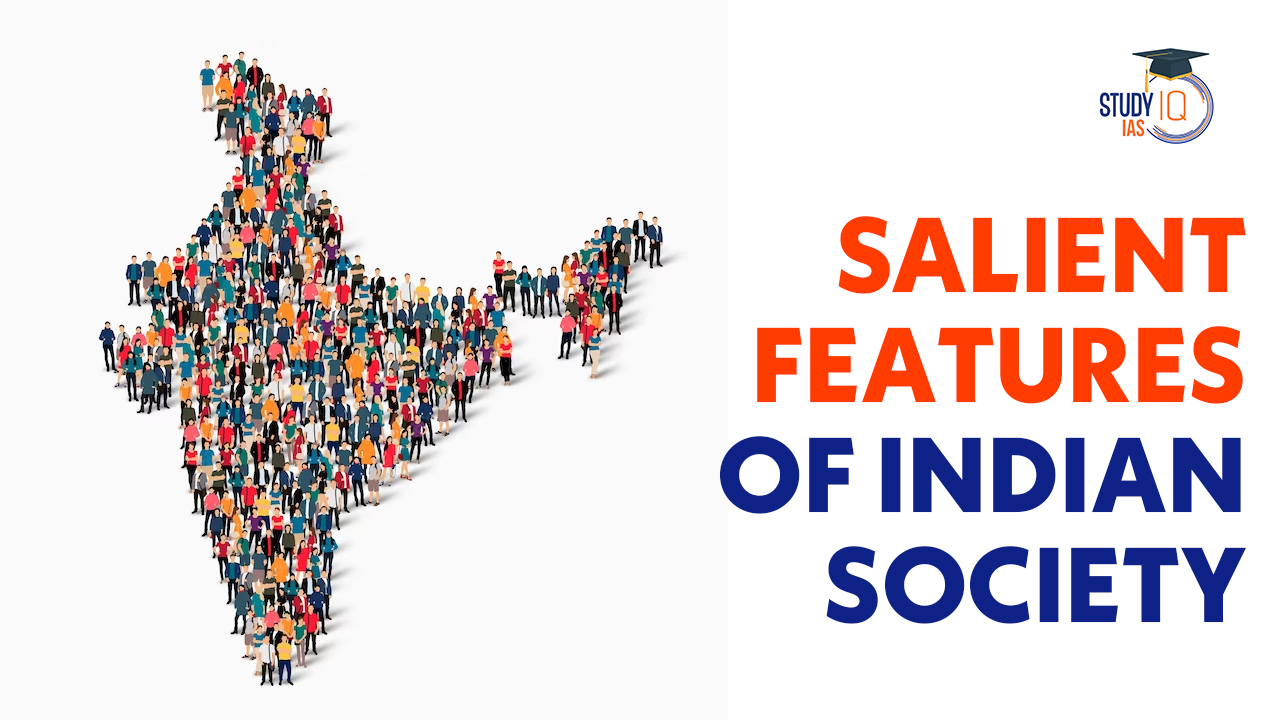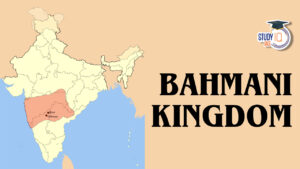Table of Contents
Salient Features of Indian Society and Culture
Indian society stands as a remarkable tapestry woven from the threads of diversity, tradition, and adaptation. It is a reflection of a nation deeply rooted in history yet propelled by the winds of change. This mosaic of social dynamics encompasses a multitude of features that have shaped the Indian identity over centuries. From its intricate caste system to the coexistence of numerous religions and languages, from the tenacity of traditional values to the currents of modernization, Indian society exhibits an intricate interplay of contrasts and harmonies.
In this exploration, we will uncover the salient features that define Indian society, providing a glimpse into its complexities and evolution. These features encapsulate the essence of a society that continues to grapple with historical legacies while carving a path towards progress and inclusivity.
Diversity and Pluralism
Indian society is characterized by its immense diversity in terms of languages, religions, cultures, traditions, and ethnic groups. This pluralistic nature has contributed to a rich and vibrant social fabric.
Read about: Surrogacy in India
Multilingualism
India’s linguistic landscape is rich and intricate, with a diversity of native languages and a prevalent practice of multilingualism. The 2011 census highlights that 121 languages are spoken as mother tongues, representing a person’s initial learned and used language.
Among these, the Constitution of India recognizes twenty-two languages as official or “scheduled” languages under the Eighth Schedule, including Assamese, Bengali, Bodo, Dogri, Gujarati, Hindi, Kannada, Kashmiri, Konkani, Maithili, Malayalam, Manipuri, Marathi, Nepali, Oriya, Punjabi, Sanskrit, Santhali, Sindhi, Tamil, Telugu, and Urdu. Additionally, six languages are designated as classical languages due to their extensive historical use and literary richness: Kannada, Malayalam, Odia, Sanskrit, Tamil, and Telugu.
Languages in India are categorized into distinct language families, such as Dravidian, Indo-Aryan, and Sino-Tibetan, often associated with varying linguistic origins and scripts. The Dravidian-rooted languages in the south showcase distinct grammatical structures and scripts, while Indo-Aryan languages in the central and northern regions use scripts derived from the Nagari script.
Multilingualism is closely intertwined with India’s states, with each mother tongue typically associated with one or more states. The nation’s linguistic organization largely follows this principle, with states established along linguistic lines since the 1950s. For instance, Andhra Pradesh was formed in 1953 for Telugu speakers, reflecting the significance of linguistic identity in India’s state boundaries.
| India’s Religious diversity as of the 2011 census | ||
| Religion | Population | Percentage |
| Hindus | 966,257,353 | 79.8% |
| Muslims | 172,245,158 | 14.2% |
| Christians | 27,819,588 | 2.3% |
| Sikhs | 20,833,116 | 1.72% |
| Buddhists | 8,442,972 | 0.7% |
| Jains | 4,451,753 | 0.37% |
| Other religions | 7,937,734 | 0.67% |
| Not stated | 2,867,303 | 0.24% |
| Total | 1,210,854,977 | 100% |
Read about: Pradhan Mantri Matru Vandana Yojana
Religious Diversity
India, as the cradle of world religions, has embraced and propagated diverse faiths, nurturing a tapestry of beliefs, rituals, and institutions. This heritage, rooted in ancestral practices, has fostered a remarkable coexistence of religions, exemplifying religious pluralism and tolerance. Amidst the backdrop of secularism, upheld by Indian citizens through tumultuous conflicts, the Constitution aptly mirrors this diversity.
It enshrines the right for every citizen to freely practice, preach, and propagate any religion or faith, emphasizing impartial treatment of all faiths. The spectrum of religions extends beyond the mainstream, encompassing tribal belief systems coexisting harmoniously. Hinduism, an ancient faith, lacks a single founder, encompassing principles like Karma, the trinity of creator, sustainer, and destroyer deities, and the theory of rebirth.
Islam, tracing its origins to 7th-century Arabia, emphasizes surrender to Allah. Christianity, with the Bible as its foundation, splits into Roman Catholics and Protestants, guided by principles encapsulated in the Ten Commandments. Sikhism, established by Guru Nanak, holds the Guru Granth Sahib as its sacred text. Sikhs revere Satnaam and are characterized by the Khalsa Panth, practising the Five Ks. Jainism, rooted in ethical conduct, was founded by Vardhaman Mahavira. It divides into Shwetambara and Digambara sects, advocating values like non-violence, truth, and non-possessiveness.
Buddhism, perceived as a universal faith, extends across the globe. Its adherents, classified as Hinayanas and Mahayanas, uphold the eightfold path as a means to alleviate suffering. This mosaic of religions portrays India’s unique ability to embrace diversity while promoting harmony and mutual respect.
Read about: Janani Suraksha yojana
Cultural Diversity
India boasts a profound cultural legacy that finds expression through a myriad of art forms, music genres, dance styles, architectural wonders, and culinary traditions. This intricate tapestry of diversity is a result of India’s extensive history and the amalgamation of countless civilizations and cultures that have thrived in the region for centuries. Among the pivotal components contributing to India’s opulent cultural heritage are:
- Music and Dance: The nation’s musical and dance heritage resonates with its multifaceted cultural mosaic. Renowned classical dance forms such as Bharatanatyam, Kathak, and Manipuri Raas Leela coexist harmoniously with an array of folk dances, reflecting a spectrum of traditions.
- Art and Architecture: India’s artistic heritage is a treasure trove of creativity, ranging from the ancient cave paintings at Ajanta and Ellora to the majestic Mughal architecture epitomized by the Taj Mahal. This panorama showcases a diverse array of influences and craftsmanship.
- Cuisine: India’s culinary landscape is celebrated globally for its boundless diversity. Distinct regional styles of cooking and a myriad of flavors are encapsulated in the spicy curries of the South and the tandoori delicacies of the North. This gastronomic journey is a mirror of India’s intricate cultural tapestry.
Read about: Mahatma Gandhi National Rural Employment Guarantee
Ethnic Diversity
- India’s societal fabric is distinctly characterized by its rich multi-ethnic tapestry. Ethnic groups, denoting individuals who share commonalities in language, history, society, culture, or nationality, form the foundation of this diversity.
- A multi-ethnic society embraces the harmonious coexistence of an array of racial groups. India stands as a testament to this concept, boasting a plethora of racial profiles, including Nordic, Dinaric, Proto-Australoid, and Mongolian, among others.
- In historical context, Herbert Risley classified India’s populace into seven distinct racial categories:
- Turko-Iranian
- Indo-Aryan
- Scytho-Dravidian
- Aryo-Dravidian
- Mongolo-Dravidian
- Mongoloid
- Dravidian
- The essence of Indian multiculturalism finds resonance in the “Salad Bowl Theory.” In this analogy, the vast Indian society parallels a salad bowl, wherein newly introduced cultures seamlessly integrate without sacrificing their individual identities. Much like the ingredients in a salad bowl, these cultures remain distinct yet contribute harmoniously to the overarching composition.
- In essence, India’s multi-ethnicity is a captivating tapestry woven from a spectrum of racial backgrounds, showcasing a harmonious blend akin to the diverse yet unified elements in a salad bowl.
Read about: Midday Meal Scheme
Caste System
India’s societal structure stands apart, marked by the caste system’s hierarchical division, distinct from other global civilizations. Originating from the Portuguese term ‘Caste,’ it categorizes individuals based on lineage purity, a unique concept within the Hindu tradition. The caste system, rooted in the chaturvarna system, established distinct Varnas during the Vedic era: Brahmins, Kshatriyas, Vaishyas, and Shudras, aligned with occupational roles and cultural practices. These primary groups further fragmented into jatis, limiting mobility across compartments.
However, this hierarchy fueled injustices, notably against the Shudras, leading to discrimination and brutality, particularly by higher castes. Dr. B. R. Ambedkar’s visionary leadership post-independence addressed this, advocating for Scheduled Castes’ inclusion in the Constitution. Referring to them as Dalits or Harijans, Ambedkar championed their upliftment and conversion to Buddhism, challenging the caste system’s foundations.
In essence, India’s caste evolution reflects a complex narrative of hierarchy and transformation, shaped by social and political endeavours, with figures like Dr. Ambedkar driving change. This history underscores the nation’s commitment to rectify inequities and create a more inclusive society. Check here Caste System in India in detail.
Read about: Pradhan Mantri Vaya Vandana Yojana
Tribalism
Within the intricate tapestry of Indian society, the tribal population stands as a remarkably diverse and heterogeneous group. They exhibit a spectrum of distinctions encompassing language usage, population size, livelihood practices, ecological environments, physical attributes, acculturation levels, developmental stages, and social hierarchies. Illustrative examples include Gonds, Bhils, and Mundas.
Distinctive Traits of Tribes
- Geographical Patterns: Tribes often inhabit specific and defined territories.
- Unity: They share a sense of cohesion within their community.
- Endogamy: Marriages commonly occur within the same tribal group.
- Shared Language: Tribes typically communicate in a common dialect.
- Protective Instinct: There’s a heightened awareness of safeguarding their cultural identity.
- Distinct Political Structure: Tribes possess unique forms of political organization.
This intricate blend of characteristics enriches the cultural fabric of India’s tribal communities.
Read about: Atal Pension Yojana
Joint Family System
The traditional joint family structure in India exhibits distinctive characteristics. Comprising three generations, it entails shared habitation, a common kitchen, and property ownership, with a dominant authority figure known as the Karta. Ritual relationships hold significance within this framework. While offering economic security, better child upbringing, and collective business management, joint families also limit individual freedom, hinder economic development, and propagate wasteful expenditures.
Women’s status is low, early marriages are promoted, and authority structures have evolved. Occupational differentiation, demographic shifts, land reforms, consumerism, modern education, legal changes, mass media influence, and technological advancements have spurred the transition from joint to smaller families. Improved health facilities and alternative institutions have further diminished the joint family’s importance.
Read about: Pradhan Mantri Jeevan Jyoti Bima Yojana
Gender Inequality
Patriarchy in India affords men primary power and status, forming a dominant social structure. Some exceptions exist in matrilineal tribal societies like the Nairs and Ezhavas in Kerala, the Khasi and Garo tribes in Meghalaya, and the Bunt and Billava communities in Karnataka, where women hold decision-making authority.
However, patriarchy persists, deeply affecting Indian women. Disparities are evident in unequal pay, with women earning 20% less for the same work. High domestic violence rates highlight the entrenched patriarchal culture. Male child preference fuels female infanticide and foeticide, reflecting gender-based bias. The dowry system perpetuates discrimination.
Read about: Pradhan Mantri Suraksha Bima Yojana
Gender inequality in India stems from various factors
- Preference for Sons: Deep-rooted cultural biases have perpetuated a preference for sons, leading to practices like female feticide and infanticide, demonstrating a harsh disregard for female lives.
- Role of Cultural Institutions: Traditional cultural institutions that emphasize patrilineality and patrilocality contribute to unequal power dynamics, where inheritance and residence favor males.
- Assumed Role of Women: Traditional gender roles dictate that women shoulder the primary burden of familial responsibilities and childcare, often necessitating their withdrawal from the workforce.
- Pink-Collarisation of Jobs: Gendered stereotypes have confined women to “pink-collar jobs” like teaching and nursing, restricting their access to diverse career opportunities.
- Discrimination at Work: Women face discrimination in the workplace, with concerns about marriage and maternity impacting their employment. Gender pay gaps persist, reflecting unequal wages for equal work.
Read about: Deen Dayal Upadhyay Antyodaya Yojana
Rural-Urban Divide
India’s society is marked by a significant rural-urban divide. Rural areas often face challenges related to infrastructure, education, healthcare, and employment opportunities. The stark rural-urban disparities in India pose a set of complex challenges that hinder equitable development. These challenges encompass a significant income gap, restricted opportunities for livelihood, inadequate infrastructure including essential services, healthcare discrepancies, and the influence of entrenched social norms.
The migration of rural inhabitants to urban areas seeking improved prospects compounds issues such as overcrowding and resource strain. Despite the presence of government programs aimed at rural development, their effectiveness is hindered by issues like corruption, lack of transparency, and mismanagement. The absence of accountability within the political and administrative spheres perpetuates these problems. Moreover, the digital divide, diminishing agricultural viability, and environmental degradation further contribute to this divide. To effectively address these multifaceted challenges, a comprehensive strategy is needed.
This should involve enhancing infrastructure, promoting comprehensive education and skills training, bolstering healthcare provisions, implementing transparent governance mechanisms, and advocating sustainable agricultural practices. Tailored solutions that consider the diverse social, economic, and cultural contexts of different regions are crucial in bridging the rural-urban gap.
Read about: Pradhan Mantri Laghu Vyapari Mandhan Yojana
Traditional Practices and Modernization
Indian society exhibits a blend of traditional practices and modern influences. This dynamic interaction can be seen in urbanization, changing family structures, and evolving cultural norms. In Indian society, a pivotal endeavour lies in maintaining an equilibrium between tradition and modernity.
This dynamic creates a perpetual state of flux, with society constantly evolving and undergoing a continuous transformative journey. A notable catalyst for change was the infusion of foreign cultures and practices during the colonial era, leaving a profound imprint on the societal fabric. The core principles driving India’s economic evolution were grounded in liberalization, privatization, and globalization (LPG), shaping the rationale and mechanisms of its growth and transformation.
Global Diaspora
The Indian diaspora is spread across the world, contributing to cross-cultural interactions, trade, and diplomacy. It reflects the global reach and influence of Indian culture and values. Thriving in developed nations, the Indian diaspora enhances India’s soft power through “diaspora diplomacy,” bridging cultural gaps and influencing elections. Their global prominence and presence in key positions amplify India’s voice in forums like the United Nations.
Economically, remittances aid families and bolster India’s Balance of Payments, while labor migration curbs disguised unemployment and supports foreign economies. Facilitating knowledge and technology transfer, they catalyze economic growth and innovation. This multifaceted contribution bolsters India’s soft power, political influence, and economic resilience worldwide.
Salient Features of Indian Society and Culture UPSC
Indian society and culture are a vibrant tapestry woven from the threads of diversity, tradition, and adaptation. From its multilingual landscape to its rich religious coexistence, India’s unique features embody a harmonious blend of contrasts. Its cultural legacy, ethnic diversity, caste system, tribalism, and evolving family structures create a complex mosaic that reflects the country’s historical evolution.
While grappling with challenges such as gender inequality and the rural-urban divide, India’s journey of embracing modernity while preserving tradition defines its ongoing transformation. The global Indian diaspora further amplifies the nation’s influence. Ultimately, India’s society stands as an intricate narrative of unity amidst diversity, shaped by its past and forging a path towards a progressive and inclusive future.


 Bahmani Kingdom (1347-1527 AD), History,...
Bahmani Kingdom (1347-1527 AD), History,...
 Indus River System, Tributaries, and Sin...
Indus River System, Tributaries, and Sin...
 Jallianwala Bagh Massacre, Date, History...
Jallianwala Bagh Massacre, Date, History...





















